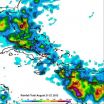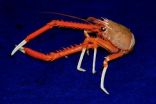(Press-News.org) CAMBRIDGE, MA -- A new study led by MIT neuroscientists has found that brain scans of patients with social anxiety disorder can help predict whether they will benefit from cognitive behavioral therapy.
Social anxiety is usually treated with either cognitive behavioral therapy or medications. However, it is currently impossible to predict which treatment will work best for a particular patient. The team of researchers from MIT, Boston University (BU) and Massachusetts General Hospital (MGH) found that the effectiveness of therapy could be predicted by measuring patients' brain activity as they looked at photos of faces, before the therapy sessions began.
The findings, published this week in the Archives of General Psychiatry, may help doctors choose more effective treatments for social anxiety disorder, which is estimated to affect around 15 million people in the United States.
"Our vision is that some of these measures might direct individuals to treatments that are more likely to work for them," says John Gabrieli, the Grover M. Hermann Professor of Brain and Cognitive Sciences at MIT, a member of the McGovern Institute for Brain Research and senior author of the paper.
Lead authors of the paper are MIT postdoc Oliver Doehrmann and Satrajit Ghosh, a research scientist in the McGovern Institute.
Choosing treatments
Sufferers of social anxiety disorder experience intense fear in social situations that interferes with their ability to function in daily life. Cognitive behavioral therapy aims to change the thought and behavior patterns that lead to anxiety. For social anxiety disorder patients, that might include learning to reverse the belief that others are watching or judging them.
The new paper is part of a larger study that MGH and BU ran recently on cognitive behavioral therapy for social anxiety, led by Mark Pollack, director of the Center for Anxiety and Traumatic Stress Disorders at MGH, and Stefan Hofmann, director of the Social Anxiety Program at BU.
"This was a chance to ask if these brain measures, taken before treatment, would be informative in ways above and beyond what physicians can measure now, and determine who would be responsive to this treatment," Gabrieli says.
Currently doctors might choose a treatment based on factors such as ease of taking pills versus going to therapy, the possibility of drug side effects, or what the patient's insurance will cover. "From a science perspective there's very little evidence about which treatment is optimal for a person," Gabrieli says.
The researchers used functional magnetic resonance imaging (fMRI) to image the brains of patients before and after treatment. There have been many imaging studies showing brain differences between healthy people and patients with neuropsychiatric disorders, but so far imaging has not been established as a way to predict patients' responses to particular treatments.
Measuring brain activity
In the new study, the researchers measured differences in brain activity as patients looked at images of angry or neutral faces. After 12 weeks of cognitive behavioral therapy, patients' social anxiety levels were tested. The researchers found that patients who had shown a greater difference in activity in high-level visual processing areas during the face-response task showed the most improvement after therapy.
Gabrieli says it's unclear why activity in brain regions involved with visual processing would be a good predictor of treatment outcome. One possibility is that patients who benefited more were those whose brains were already adept at segregating different types of experiences, Gabrieli says.
The researchers are now planning a follow-up study to investigate whether brain scans can predict differences in response between cognitive behavioral therapy and drug treatment.
"Right now, all by itself, we're just giving somebody encouraging or discouraging news about the likely outcome" of therapy, Gabrieli says. "The really valuable thing would be if it turns out to be differentially sensitive to different treatment choices."
###The research was funded by the Poitras Center for Affective Disorders Research and the National Institute of Mental Health.
Written by Anne Trafton, MIT News Office
Predicting how patients respond to therapy
Brain scans could help doctors choose treatments for people with social anxiety disorder
2012-09-06
ELSE PRESS RELEASES FROM THIS DATE:
'I knew it all along…didn't I?' – Understanding hindsight bias
2012-09-06
The fourth-quarter comeback to win the game. The tumor that appeared on a second scan. The guy in accounting who was secretly embezzling company funds. The situation may be different each time, but we hear ourselves say it over and over again: "I knew it all along."
The problem is that too often we actually didn't know it all along, we only feel as though we did. The phenomenon, which researchers refer to as "hindsight bias," is one of the most widely studied decision traps and has been documented in various domains, including medical diagnoses, accounting and auditing ...
NASA satellite captured Hurricane Leslie's picture perfect moment
2012-09-06
NASA's Aqua satellite flew over Tropical Storm Leslie on Sept. 5 during a picture perfect moment, just as it was being re-classified as a hurricane, and captured two images of the storm.
The National Hurricane Center issued the advisory confirming Leslie's hurricane status at 1:45 p.m. EDT after examining visible, infrared, microwave and other data from satellites. Two instruments that fly aboard NASA's Aqua satellite provided infrared and visible imagery of Leslie as it was crossing the threshold from tropical storm to hurricane status on Sept. 5.
The Moderate Resolution ...
More grandparents fill caregiver role
2012-09-06
Grandparents, an increasingly important source of child care in the United States, vary greatly in the kind of care they provide, depending on their age, resources, and the needs of their children, research at the University of Chicago shows.
A new UChicago study, based on a National Institute on Aging survey, shows that 60 percent of grandparents provided some care for their grandchildren during a 10-year period, and 70 percent of those who did provided care for two years or more.
The results mirror recent U.S. Census data showing the importance of grandparents in ...
NASA analyzes Isaac's rainfall: Drought relief and flooding
2012-09-06
As it passed through the northern Caribbean, around south Florida, and into Louisiana and the Middle Mississippi Valley, Hurricane Isaac brought lots of rain, some of it beneficial, and some of it not. Using data from the TRMM satellite, NASA created images of rainfall totals generated along Hurricane Isaac's path.
In addition to capturing detailed images of tropical storms, the Tropical Rainfall Measuring Mission (TRMM) satellite is ideally suited to measure rainfall from space. TRMM is managed by NASA and the Japanese Space Agency, JAXA. For increased coverage, TRMM ...
Mining the blogosphere
2012-09-06
Montreal, September 6, 2012 – Can a computer "read" an online blog and understand it? Several Concordia computer scientists are helping to get closer to that goal.
Leila Kosseim, associate professor in Concordia's Faculty of Engineering and Computer Science, and a recently-graduated doctoral student, Shamima Mithun, have developed a system called BlogSum that has potentially vast applications. It allows an organization to pose a question and then find out how a large number of people talking online would respond. The system is capable of gauging things like consumer preferences ...
In Rochester, a tale of tainted tattoos
2012-09-06
If you end up with a rash on a new tattoo, you should probably think twice before brushing it off as an allergic reaction or a normal part of the healing process.
A recent study in the New England Journal of Medicine documents 19 cases in the Rochester, N.Y., area – the largest ever reported – of tattoos infected with a type of bacteria often found in tap water. Evidence points to a premixed gray ink, the type used in currently popular portrait or photography tattoos, as the culprit.
Mary Gail Mercurio, M.D., a dermatologist at the University of Rochester Medical ...
Deep-sea crabs seek food using ultraviolet vision
2012-09-06
HOLLYWOOD Fla. — Some deep-sea crabs have eyes sensitive to ultraviolet light, which they may use to snatch glowing plankton and stuff it in their mouths, a new Nova Southeastern University study suggests.
Tamara Frank, Ph.D., a marine biologist and associate professor at Nova Southeastern University's Oceanographic Center, who is the principal investigator of the study, said that crabs living the deep-sea zone --- a pitch dark area at the ocean bottom ---- may be using bioluminescence to help sort out their food.
Duke University marine biologist Sönke Johnsen. Ph.D., ...
CNIO participates in the ENCODE project: A stride forward in biomedical research
2012-09-06
The international Encode project, a collaborative study bringing together hundred of scientists from all round the world, including researchers working at the Spanish National Cancer Research Centre (CNIO), published results yesterday mapping the control and regulation of genome activity. These results indicate a total of four million 'switches' controlling the gene activity of 147 types of human cells and tissue. This map provides us with the first comprehensive vision of the genome as a complex web of interactions, and goes far beyond our initial thinking, which assigned ...
Urban Real Estate Development Firm Launches Digital Brand
2012-09-06
With the impending completion of redevelopment on 1 & 7 Ionia and another property closing in downtown Grand Rapids, Michigan, soon to be announced, urban real estate development firm 616 Development is establishing its brand in the digital space. The company's new website, 616Development.com, offers detailed insights into the company's founding, its core members, key development projects and its unique approach to urban development. Alongside engagement in prominent social networks, the website lays the foundation for the brand's voice in both digital and non-digital ...
Picky penguins: Does mate choice depend on genes that help resist disease?
2012-09-06
NEWPORT, Ore. – Magellanic penguins have a high level of variation in genes associated with the ability to fight infectious disease, but a recent study found that the mechanism the penguins use to ensure that diversity is far from black and white.
Found exclusively south of the equator in South America, Magellanic penguins assemble in large nesting colonies along the coasts of Argentina, Chile, and the Falkland Islands. They typically mate for life, producing clutches of two eggs that are cared for by both parents. While individual colonies can number in the millions ...
LAST 30 PRESS RELEASES:
Sea reptile’s tooth shows that mosasaurs could live in freshwater
Pure bred: New stem cell medium only has canine components
Largest study of its kind highlights benefits – and risks – of plant-based diets in children
Synergistic effects of single-crystal HfB2 nanorods: Simultaneous enhancement of mechanical properties and ablation resistance
Mysterious X-ray variability of the strongly magnetized neutron star NGC 7793 P13
The key to increasing patients’ advance care medical planning may be automatic patient outreach
Palaeontology: Ancient tooth suggests ocean predator could hunt in rivers
Polar bears may be adapting to survive warmer climates, says study
Canadian wildfire smoke worsened pediatric asthma in US Northeast: UVM study
New UBCO research challenges traditional teen suicide prevention models
Diversity language in US medical research agency grants declined 25% since 2024
Concern over growing use of AI chatbots to stave off loneliness
Biomedical authors often call a reference “recent” — even when it is decades old, analysis shows
The Lancet: New single dose oral treatment for gonorrhoea effectively combats drug-resistant infections, trial finds
Proton therapy shows survival benefit in Phase III trial for patients with head and neck cancers
Blood test reveals prognosis after cardiac arrest
UBCO study finds microdosing can temporarily improve mood, creativity
An ECOG-ACRIN imaging study solves a long-standing gap in metastatic breast cancer research and care: accurately measuring treatment response in patients with bone metastases
Cleveland Clinic presents final results of phase 1 clinical trial of preventive breast cancer vaccine study
Nationally renowned anesthesiology physician-scientist and clinical operations leader David Mintz, MD, PhD, named Chair of the Department of Anesthesiology at the UM School of Medicine
Clean water access improves child health in Mozambique, study shows
Study implicates enzyme in neurodegenerative conditions
Tufts professor named Fellow of the National Academy of Inventors
Tiny new device could enable giant future quantum computers
Tracing a path through photosynthesis to food security
First patient in Arizona treated with new immune-cell therapy at HonorHealth Research Institute
Studies investigate how AI can aid clinicians in analyzing medical images
Researchers pitch strategies to identify potential fraudulent participants in online qualitative research
Sweeping study shows similar genetic factors underlie multiple psychiatric disorders
How extreme weather events affect agricultural trade between US states
[Press-News.org] Predicting how patients respond to therapyBrain scans could help doctors choose treatments for people with social anxiety disorder



